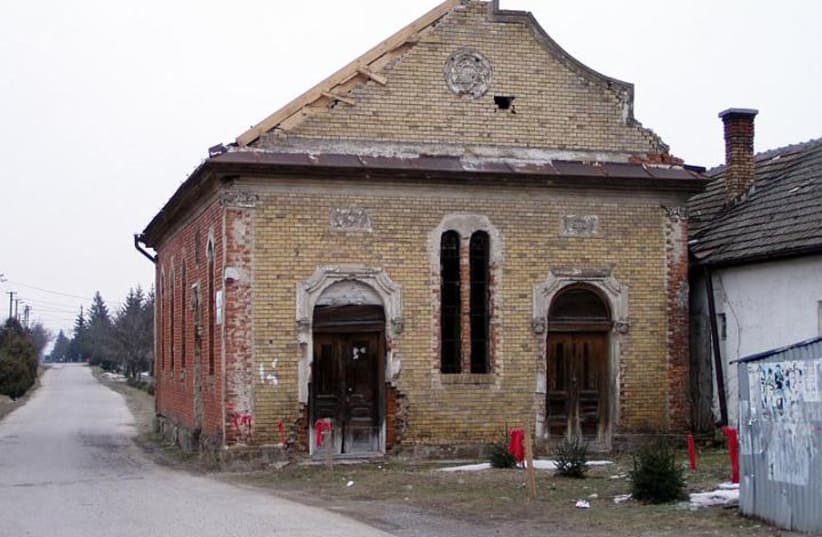Dov Ehrman was born around 1860 and grew up in the hassidic cultural milieu of Hungary and Galicia. He lived in Perbenyik, Hungary (today Pribeník, Slovakia), and visited the hassidic masters of Belz, Sighet, Munkatch, and others.
At the beginning of the 20th century, Ehrman published a two-volume collection of hassidic tales titled Devarim Areivim. According to the title page, this work was over 20 years in the making: Ehrman began to transcribe the tales in 1881, with the first volume being published in 1903 and the second in 1905. Both volumes were published in Munkács. Devarim Areivim included tales from the earliest hassidic masters in the 18th century, through to the leaders of the movement in the early 19th century.
Less than a decade later, Ehrman continued his literary activity when he published another collection of hassidic tales titled Pe’er Vekhavod, printed in Munkács in 1911. Perhaps the initial print run was limited or perhaps the book was snapped up by eager readers; whatever the case, Pe’er Vekhavod was reprinted a year later by the same printing press in Munkács.
The difference between the two printings – one detail on the title page – is almost imperceptible. The title page of the 1911 edition identifies the publisher as “B. Ehrman Perbenyik,” whereas in 1912 he is identified as “B. Ehrman Kisvárda.” Perbenyik is a modest town. The building that served as the synagogue still stands, and after extensive repairs, it was reopened in 2006 as the Gallery of Nations, though signs of the building’s former use are apparent. In Jewish circles, Kisvárda was known by the German name Kleinwardein, and it was a Jewish stronghold with over 3,000 Jews who constituted approximately a third of the local population. It seems that Ehrman moved from the rural Perbenyik to the urban Kisvárda.
It appears that Ehrman had intended to print a second volume of Pe’er Vekhavod – just as he had done with his Devarim Areivim – since the title page of Pe’er Vekhavod declares that this is part one. Alas, no Pe’er Vekhavod part two was ever issued.
Pe’er Vekhavod included stories from four hassidic masters from two dynasties: Rabbi Moshe Teitelbaum of Újhely (Yismach Moshe, 1759-1841) and his grandson Rabbi Yekutiel Yehuda Teitelbaum of Sighet (Kedushat Yom Tov, 1808-1883) – the forerunners of what would become the Satmar Hassidism after the Holocaust; Rabbi Shalom Rokeah (1781-1855), the founder of Belz Hassidism, and his son and successor Rabbi Yehoshua Rokeah (1825-1894). While these four personalities were the focus of the collection, tales of other hassidic masters were also included.
EHRMAN CONTINUED his literary output, producing a third collection of hassidic tales, titled Zokhreinu Lehayim. This work was published in 1937 in the same city – but not the same country – where Ehrman had published his previous works, Mukačevo, now in Czechoslovakia. Zokhreinu Lehayim includes tales about Rabbi Hayim Halberstam of Tzanz (1793-1876) and his son Rabbi Yehezkel Shraga Halberstam of Sieniawa (1813-1898), as well as other hassidic miscellany. The volume included some 30 pages about Rabbi Hayim Elazar Spira of Munkács (1871-1937) who passed away about half a year before the volume was published. This was one of the earliest posthumous accounts of the colorful and outspoken rebbe from Munkatch.
Here too a second volume may have been in the offing, as the title page declares this to be part one. As with Pe’er Vekhavod part two, there was no Zokhreinu Lehayim part two.
Around 1941, with the Second World War raging but Hungarian Jewry yet to be targeted, Ehrman moved to Ungvár (today Uzhhorod, Ukraine). In the summer of 1944, Ehrman – together with much of Hungarian Jewry – was killed.
All told, Ehrman bequeathed four volumes to posterity; a veritable goldmine of hassidic tales, vignettes, and anecdotes.
Tales of devekut from hassidic masters
IN Pe’er Vekhavod, Ehrman shared a fascinating exchange between two hassidic masters in the 19th century: the aforementioned Kedushat Yom Tov and Rabbi Shlomo Spira of Munkács (1831-1893) – the grandfather of the aforementioned Rabbi Hayim Elazar.
The two masters were recounting tales of hassidic masters of previous generations. The Kedushat Yom Tov shared a scene from his grandfather’s table: The hassidim who were sitting at the table were in such a lofty state of devekut (focused communion with the Almighty), that they were unaware whether or not the main course had been served.
Rabbi Shlomo of Munkács responded with another vignette that concerned the hassidim of Rabbi Uri of Strelisk (1757-1826). Rabbi Uri was known for striving for extreme states of devekut during prayer. Strelisk hassidim – recounted Rabbi Shlomo of Munkács – once reached such detached states of devekut that they were unaware that the Torah scroll had been taken from the ark of the very synagogue where they were praying (the mysterious missing Torah episode appears in Ehrman’s Devarim Areivim and it was recounted in The Jerusalem Post, 20.1.2023).
The Kedushat Yom Tov and Rabbi Shlomo of Munkács may have mulled over the two stories for a few minutes, and on the two devekut scenarios in particular. Eventually the hassidic masters agreed over the relative worth of each spiritual achievement: The devekut of the Újhely hassidim during the meal was a greater accomplishment than the devekut of the Strelisk hassidim during prayer.
The Kedushat Yom Tov and Rabbi Shlomo of Munkács explained: Devekut during prayer is not an innovation; that is exactly what we strive for during prayer. But to achieve a state of devekut while eating – that is truly a laudable feat! ■
The writer is on the faculty of the Pardes Institute of Jewish Studies and is a rabbi in Tzur Hadassah.

